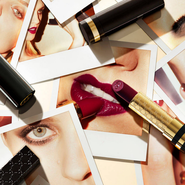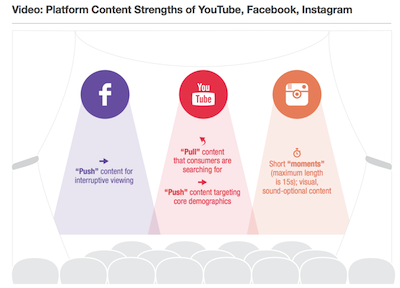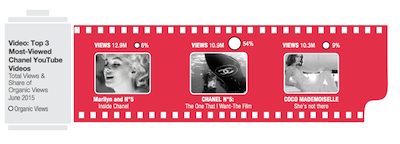 Gucci Cosmetics
Gucci Cosmetics
According to a new report by L2, video bloggers in the beauty space generate more than 700 million views on YouTube per month, showing the value of filmed content.
These influencers now have more clout with younger consumers than most mainstream celebrities due to the authentic and approachable format video blogging allots, making collaborative partnerships with revered video bloggers worthwhile for beauty marketers. The L2 “Intelligence Report: Video 2015” also found that posts from popular video bloggers achieve two times the number of views as the monthly circulations of top magazines targeting the same demographic.
“Video is an amazing medium for storytelling, which makes it ideal for luxury brands—many consumers will have a lot more organic interest in watching a mini-movie produced by Chanel than the average re-purposed commercial from, for example, Tide,” said Mabel McLean, study lead at L2’s Intelligence Group.
“Social video campaigns offer luxury brands to distribute content at a scale comparable to linear TV, but with more sophisticated targeting capabilities and at a lower cost,” she said.
For the Intelligence Report: Video 2015, L2 looked at the online video efforts of 245 brands across 8 different verticals with a focus on beauty and hair care brands. L2 Intelligence Reports complement the researcher’s flagship Digital IQ Index by delving deeper into platforms or geographies. Areas include mobile, video, emerging platforms and omnichannel retail.
Video vibes
In 2014, digital video spend had increased by 52 percent and is now on track to increase even more as marketers amp up their spend to fully capitalize on what video has to offer, mainly its high level of viewer engagement. Determining the best way to create quality content remains a challenge with 34 percent of brands citing a lack of in-house resources.
YouTube and Facebook lead the way in which young and affluent consumers view branded video content. YouTube had 161.7 million views in January 2015 with a near even split between the genders while Facebook saw 92.9 million views and viewers were 42 percent male and 58 percent female.
As popular as Instagram is for image sharing, its video capabilities do not result in high monthly views, with only 17.2 million in January 2015. This is reflective of marketer’s challenges to create worthwhile content within the 15-second time allotment on the platform.
Because of a “push” and “pull” model, YouTube and Facebook fare better. YouTube pulls content consumers are searching for and pushes content to targeted demographics while Facebook pushes content for “interruptive viewing.”
 L2 infographic highlighting how Facebook, YouTube and Instagram promote video content
In total, YouTube accounts for approximately 20 percent of the U.S. digital video ad market with paid support, referred to as TrueView In-Stream content, needed for videos to achieve significant scale. In the beauty and hair care sector, only three brand channels have earned above-average in total channel view and organic view shares: Chanel, em Cosmetics and YSL Beauty.
Interestingly, more than half of the most viewed videos in the first quarter of 2015 were repurposed television spots, highlighting the change in spend and consumer behavior.
Chanel, for instance, has more views than another brand in the beauty and personal care sector and an above-average organic ratio. This is partly due to the brand’s promotions of its fragrance video campaigns and because those associated with Chanel fashion add to the brand’s organic success.
As an example, the brand’s “Marilyn and N°5” chapter for its “Inside Chanel” series garnered the most views with 12.9 million in June 2015 with 6 percent of viewing being organic (see story).
L2 infographic highlighting how Facebook, YouTube and Instagram promote video content
In total, YouTube accounts for approximately 20 percent of the U.S. digital video ad market with paid support, referred to as TrueView In-Stream content, needed for videos to achieve significant scale. In the beauty and hair care sector, only three brand channels have earned above-average in total channel view and organic view shares: Chanel, em Cosmetics and YSL Beauty.
Interestingly, more than half of the most viewed videos in the first quarter of 2015 were repurposed television spots, highlighting the change in spend and consumer behavior.
Chanel, for instance, has more views than another brand in the beauty and personal care sector and an above-average organic ratio. This is partly due to the brand’s promotions of its fragrance video campaigns and because those associated with Chanel fashion add to the brand’s organic success.
As an example, the brand’s “Marilyn and N°5” chapter for its “Inside Chanel” series garnered the most views with 12.9 million in June 2015 with 6 percent of viewing being organic (see story).
 L2 infographic showing Chanel's top 3 most-viewed YouTube videos
YouTube’s TrueView In-Stream was also used when Estée Lauder announced model Kendall Jenner as its latest ambassador in November 2014 (see story). By boosting the video campaign’s visibility, Estée Lauder sourced 65 percent of its total views.
Essentially, marketers must realize that a “viral video” is a myth and paid support is necessary for a video’s success. L2 found that brands with YouTube channels boasting above-average view counts use TrueView In-Stream to attract 85 percent of views and that average YouTube channels source more than half through advertising.
In comparison, video content views on Facebook are not relative to community size in all cases. L2 explains that Facebook impression volume is determined by daily advertising budgets, meaning that if a brand increases the budget behind a piece of content its exposure and view count will accelerate.
Also, engagement tends to decrease as view count rises, regardless of audience size. For beauty and personal care videos published in Q1 of 2015, L2 found a weak, negative relationship between engagement and view count. However, this is dependent on the film published, and engagement performance should be considered relative to reach.
Indeed, the featured product in the video is an important component for successful engagement. For example, French jeweler Cartier produced a mini-movie, “The Proposal” which was viewed 440,000 times for an engagement rate of 4.9 percent, but detailed clips of the featured jewelry generated 18.6 percent engagement and 7,000 views (see story).
Tutorial tutors
Video has expanded marketing from traditional television campaigns repurposed for a smaller screen to how-to films that boost engagement and assist consumers in grasping on-trend beauty styles.
Although only accounting for 12 percent of the top 100 most-engaged Facebook posts, this type of content creates powerful engagement. Tutorials are ideal for nail polish brands, but cosmetics also find value in the content through product awareness and procedure.
For instance, Dior’s top beauty tutorial featuring its spring 2015 cosmetic collection, “Kingdom of Colors,” generated 376,117 total views with an engagement rate of 8.5 percent.
As disruptive as digital has been to the print industry, media brands such as Condé Nast have capitalized on the changing times by increasing video output, including tutorialized content.
Condé Nast Britain is expanding the coverage found on Vogue Video to include beauty content to further the video hub’s positioning as a one-stop resource for consumers.
Vogue Video launched in June with the “Vogue Presents The Minion” mockumentary, a fun introduction to the new facet of Condé Nast Britain (see story), and since its debut the film has been viewed 2.5 million times, showing that there is an interest for publication-curated video content. By expanding its fashion-centric coverage into other relevant areas, Vogue Video will increase its audience and further establish its premiere content in a new way (see story).
However, the television industry has felt online video’s impact the most.
"In general, an increasing portion of brand media budgets are being allocated to digital over traditional media. However, we see digital video as more disruptive to linear TV rather than print," Ms. McLean said. "Few on-demand, digital video substitutes for live TV broadcasts have advertising, and digital video advertising is a great way to reach this coveted 'cord cutter' demographic, which skews young and wealthy.
"However, digital video is facing off with traditional print in some interesting ways," she said. "For example, YouTube beauty video bloggers have become the first source of reference that many teens and millennials turn to for beauty advice—a sphere of influence that used to be dominated by magazines such as Cosmo, Glamour, etc.
"Once more, the average popular video blogger video attracts two times more views than the monthly circulations of many of these top magazines targeting the same demographics."
Final Take
Jen King, lead reporter on Luxury Daily, New York
L2 infographic showing Chanel's top 3 most-viewed YouTube videos
YouTube’s TrueView In-Stream was also used when Estée Lauder announced model Kendall Jenner as its latest ambassador in November 2014 (see story). By boosting the video campaign’s visibility, Estée Lauder sourced 65 percent of its total views.
Essentially, marketers must realize that a “viral video” is a myth and paid support is necessary for a video’s success. L2 found that brands with YouTube channels boasting above-average view counts use TrueView In-Stream to attract 85 percent of views and that average YouTube channels source more than half through advertising.
In comparison, video content views on Facebook are not relative to community size in all cases. L2 explains that Facebook impression volume is determined by daily advertising budgets, meaning that if a brand increases the budget behind a piece of content its exposure and view count will accelerate.
Also, engagement tends to decrease as view count rises, regardless of audience size. For beauty and personal care videos published in Q1 of 2015, L2 found a weak, negative relationship between engagement and view count. However, this is dependent on the film published, and engagement performance should be considered relative to reach.
Indeed, the featured product in the video is an important component for successful engagement. For example, French jeweler Cartier produced a mini-movie, “The Proposal” which was viewed 440,000 times for an engagement rate of 4.9 percent, but detailed clips of the featured jewelry generated 18.6 percent engagement and 7,000 views (see story).
Tutorial tutors
Video has expanded marketing from traditional television campaigns repurposed for a smaller screen to how-to films that boost engagement and assist consumers in grasping on-trend beauty styles.
Although only accounting for 12 percent of the top 100 most-engaged Facebook posts, this type of content creates powerful engagement. Tutorials are ideal for nail polish brands, but cosmetics also find value in the content through product awareness and procedure.
For instance, Dior’s top beauty tutorial featuring its spring 2015 cosmetic collection, “Kingdom of Colors,” generated 376,117 total views with an engagement rate of 8.5 percent.
As disruptive as digital has been to the print industry, media brands such as Condé Nast have capitalized on the changing times by increasing video output, including tutorialized content.
Condé Nast Britain is expanding the coverage found on Vogue Video to include beauty content to further the video hub’s positioning as a one-stop resource for consumers.
Vogue Video launched in June with the “Vogue Presents The Minion” mockumentary, a fun introduction to the new facet of Condé Nast Britain (see story), and since its debut the film has been viewed 2.5 million times, showing that there is an interest for publication-curated video content. By expanding its fashion-centric coverage into other relevant areas, Vogue Video will increase its audience and further establish its premiere content in a new way (see story).
However, the television industry has felt online video’s impact the most.
"In general, an increasing portion of brand media budgets are being allocated to digital over traditional media. However, we see digital video as more disruptive to linear TV rather than print," Ms. McLean said. "Few on-demand, digital video substitutes for live TV broadcasts have advertising, and digital video advertising is a great way to reach this coveted 'cord cutter' demographic, which skews young and wealthy.
"However, digital video is facing off with traditional print in some interesting ways," she said. "For example, YouTube beauty video bloggers have become the first source of reference that many teens and millennials turn to for beauty advice—a sphere of influence that used to be dominated by magazines such as Cosmo, Glamour, etc.
"Once more, the average popular video blogger video attracts two times more views than the monthly circulations of many of these top magazines targeting the same demographics."
Final Take
Jen King, lead reporter on Luxury Daily, New York
